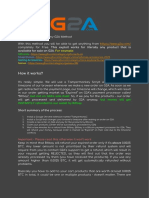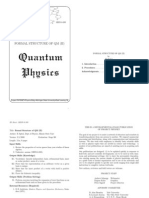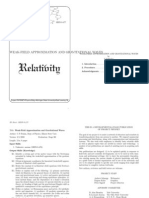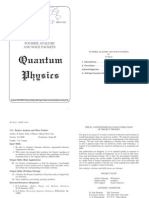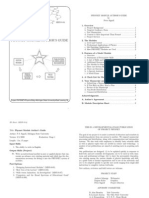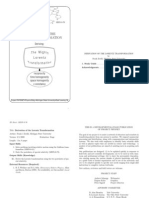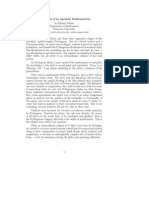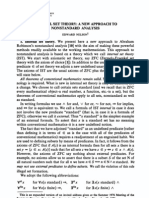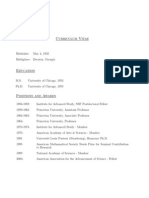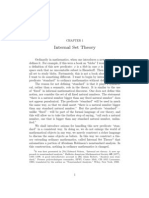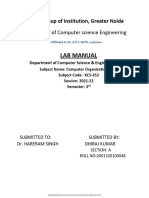Classical Mechanics: Calculus of Variations
Classical Mechanics: Calculus of Variations
Uploaded by
Epic WinOriginal Description:
Original Title
Copyright
Available Formats
Share this document
Did you find this document useful?
Is this content inappropriate?
Report this DocumentCopyright:
Available Formats
Classical Mechanics: Calculus of Variations
Classical Mechanics: Calculus of Variations
Uploaded by
Epic WinCopyright:
Available Formats
MISN-0-497
CALCULUS OF VARIATIONS
Classical Mechanics
Project PHYSNET Physics Bldg. Michigan State University East Lansing, MI
CALCULUS OF VARIATIONS by C. P. Frahm 1. Introduction . . . . . . . . . . . . . . . . . . . . . . . . . . . . . . . . . . . . . . . . . . . . . . 1 2. Procedures . . . . . . . . . . . . . . . . . . . . . . . . . . . . . . . . . . . . . . . . . . . . . . . . 1 Acknowledgments. . . . . . . . . . . . . . . . . . . . . . . . . . . . . . . . . . . . . . . . . . . .2
ID Sheet: MISN-0-497 THIS IS A DEVELOPMENTAL-STAGE PUBLICATION OF PROJECT PHYSNET The goal of our project is to assist a network of educators and scientists in transferring physics from one person to another. We support manuscript processing and distribution, along with communication and information systems. We also work with employers to identify basic scientic skills as well as physics topics that are needed in science and technology. A number of our publications are aimed at assisting users in acquiring such skills. Our publications are designed: (i) to be updated quickly in response to eld tests and new scientic developments; (ii) to be used in both classroom and professional settings; (iii) to show the prerequisite dependencies existing among the various chunks of physics knowledge and skill, as a guide both to mental organization and to use of the materials; and (iv) to be adapted quickly to specic user needs ranging from single-skill instruction to complete custom textbooks. New authors, reviewers and eld testers are welcome. PROJECT STAFF Andrew Schnepp Eugene Kales Peter Signell Webmaster Graphics Project Director
Title: Calculus of Variations Author: C. P. Frahm, Physics Dept., Illinois State Univ Version: 2/1/2000 Length: 2 hr; 8 pages Input Skills: 1. Calculate the area of the surface of revolution of a given curve. 2. Write down expressions for the potential and kinetic energies of an oscillator (MISN-0-495) and a linear pendulum (MISN-0-493). Output Skills (Knowledge): K1. State the basic problem of the calculus of variations and describe in general terms the method of solution. K2. Derive Eulers equation for one dependent variable. K3. Derive the second form of Eulers equation applicable when the integrand is not on explicit function of x (the independent variable). K4. Derive Eulers equations for several dependent variables. Output Skills (Problem Solving): S1. Use the variational technique and Eulers equations to solve the brachistochrone problem, to nd geodesics on simple surfaces, to nd the function which has the minimum surface of revolution, and other such problems. External Resources (Required): 1. J. Marion, Classical Dynamics, Academic Press (1988). Evaluation: Stage B0
ADVISORY COMMITTEE D. Alan Bromley E. Leonard Jossem A. A. Strassenburg Yale University The Ohio State University S. U. N. Y., Stony Brook
Views expressed in a module are those of the module author(s) and are not necessarily those of other project participants. c 2001, Peter Signell for Project PHYSNET, Physics-Astronomy Bldg., Mich. State Univ., E. Lansing, MI 48824; (517) 355-3784. For our liberal use policies see: http://www.physnet.org/home/modules/license.html.
MISN-0-497
MISN-0-497
CALCULUS OF VARIATIONS by C. P. Frahm 1. Introduction
One of the most intriguing properties of nature is its apparent fondness for variational principles. Almost every class of physical phenomena from classical mechanics to general relativity can be formulated in terms of a variational principle. In classical mechanics the variational principle is known as Hamiltons Principle while in geometrical optics, it is known as Fermats Principle. As well as providing a useful tool for the solution of certain kinds of problems, these variational principles provide an elegant new point-of-view from which one can gain new insights into the behavior of physical systems. This unit will cover the mathematical methods of variational calculus while subsequent units will treat Hamiltons principle and its application to mechanics.
4. Read Example 5.2 in Marion. In the brachistochrone problem, it is assumed that the particle slides on a frictionless surface under the inuence of gravity. The problem is to nd the shape of the surface that minimizes the travel time. Read example 6.4 on geodesics in Marion. Work problems 6-3, 6-4 in Marion. Work problem 6-5 in Marion, using eq. 6.18.
Acknowledgments
The author would like to thank Illinois State University for support in the construction of this lesson. Preparation of this module was supported in part by the National Science Foundation, Division of Science Education Development and Research, through Grant #SED 74-20088 to Michigan State University.
2. Procedures
1. Read Sections 6.1 and 6.2 in Marion. Omit Example 6.1. The two examples given in the section 6.2 are a little misleading since they yield extrema only for a special class of trial functions. In general, one wishes to nd extrema for arbitrary trial functions and, in fact, one usually does not specify the form of the trial functions. 2. Read section 6-3 in Marion and ll in any missing details. This is the fundamental variational technique and should be studied carefully. 3. Read sections 6.4 and 6.5 in Marion. Optional: Read Chapter 17 of Arfken. A number of worked-out examples are given in this reference.
You might also like
- Mechanics of Materials Laboratory CourseDocument228 pagesMechanics of Materials Laboratory CourseMark Yen100% (1)
- Introduction of Sieyuan 2021Document55 pagesIntroduction of Sieyuan 2021Dalibor Markovic100% (1)
- Marketing Canadian 3rd Edition Grewal Test BankDocument31 pagesMarketing Canadian 3rd Edition Grewal Test BankLobna QassemNo ratings yet
- Part 1 Operators Manual GB PDFDocument88 pagesPart 1 Operators Manual GB PDFJaa Jawad Enn100% (1)
- G2a Exploit Last Updated 28 DecemberDocument9 pagesG2a Exploit Last Updated 28 DecemberWillard Delos SantosNo ratings yet
- Classical Mechanics: Vector AnalysisDocument4 pagesClassical Mechanics: Vector AnalysisEpic WinNo ratings yet
- Classical Mechanics: Rigid Bodies The Inertia TensorDocument4 pagesClassical Mechanics: Rigid Bodies The Inertia TensorEpic WinNo ratings yet
- Relativity: Einstein'S Field EquationsDocument4 pagesRelativity: Einstein'S Field EquationsEpic WinNo ratings yet
- Math Physics: Fourier Integrals: Part 1Document4 pagesMath Physics: Fourier Integrals: Part 1Epic WinNo ratings yet
- Time-Independent Perturbations: Project PHYSNET Physics Bldg. Michigan State University East Lansing, MIDocument4 pagesTime-Independent Perturbations: Project PHYSNET Physics Bldg. Michigan State University East Lansing, MIEpic WinNo ratings yet
- Math Physics: Integral Calculus For VectorsDocument4 pagesMath Physics: Integral Calculus For VectorsEpic WinNo ratings yet
- The Gravitational Field: Project PHYSNET Physics Bldg. Michigan State University East Lansing, MIDocument6 pagesThe Gravitational Field: Project PHYSNET Physics Bldg. Michigan State University East Lansing, MIEpic WinNo ratings yet
- Electricity and Magnetism: Electromagnetic WavesDocument4 pagesElectricity and Magnetism: Electromagnetic WavesEpic WinNo ratings yet
- Electricity and Magnetism: Review of Vector AnalysisDocument4 pagesElectricity and Magnetism: Review of Vector AnalysisEpic WinNo ratings yet
- M 315Document4 pagesM 315Epic WinNo ratings yet
- Classical Mechanics: Newtonian Mechanics - Single ParticleDocument8 pagesClassical Mechanics: Newtonian Mechanics - Single Particlep_k_soni_iit_physicsNo ratings yet
- Classical Mechanics: Matrices and TransformationsDocument5 pagesClassical Mechanics: Matrices and TransformationsEpic WinNo ratings yet
- Formal Structure of QM (Ii) : Project PHYSNET Physics Bldg. Michigan State University East Lansing, MIDocument5 pagesFormal Structure of QM (Ii) : Project PHYSNET Physics Bldg. Michigan State University East Lansing, MIEpic WinNo ratings yet
- Transitions and Spectral Analysis: Two Slit Images (Two Lines)Document4 pagesTransitions and Spectral Analysis: Two Slit Images (Two Lines)Epic WinNo ratings yet
- Computational Nanomechanics of Materials: Wing Kam Liu, Sukky Jun, and Dong QianDocument27 pagesComputational Nanomechanics of Materials: Wing Kam Liu, Sukky Jun, and Dong QianQaisNo ratings yet
- Relativistic Energy and Momentum: DerivationDocument4 pagesRelativistic Energy and Momentum: DerivationEpic WinNo ratings yet
- Foucault'S Pendulum: Project PHYSNET Physics Bldg. Michigan State University East Lansing, MIDocument4 pagesFoucault'S Pendulum: Project PHYSNET Physics Bldg. Michigan State University East Lansing, MIEpic WinNo ratings yet
- The Numerov Algorithm For Magnetic Field TrajectoriesDocument4 pagesThe Numerov Algorithm For Magnetic Field Trajectoriesp_k_soni_iit_physicsNo ratings yet
- Relativity: Weak-Field Approximation and Gravitational WavesDocument4 pagesRelativity: Weak-Field Approximation and Gravitational WavesEpic WinNo ratings yet
- Classical Mechanics: Central Force MotionDocument6 pagesClassical Mechanics: Central Force MotionEpic WinNo ratings yet
- Special Relativity: The Michelson-Morley Experiment: FlashlightDocument4 pagesSpecial Relativity: The Michelson-Morley Experiment: FlashlightEpic WinNo ratings yet
- Magnetic Fields in Bulk Matter: Magnets: Project PHYSNET Physics Bldg. Michigan State University East Lansing, MIDocument4 pagesMagnetic Fields in Bulk Matter: Magnets: Project PHYSNET Physics Bldg. Michigan State University East Lansing, MIEpic WinNo ratings yet
- Van HieleDocument207 pagesVan HieleDan Hanson100% (1)
- Harmonic Perturbations: Project PHYSNET Physics Bldg. Michigan State University East Lansing, MIDocument4 pagesHarmonic Perturbations: Project PHYSNET Physics Bldg. Michigan State University East Lansing, MIEpic WinNo ratings yet
- M 254Document4 pagesM 254Epic WinNo ratings yet
- Relativity: Introduction To General RelativityDocument4 pagesRelativity: Introduction To General RelativityEpic WinNo ratings yet
- Moments of Inertia, Principal Moments: Project PHYSNET Physics Bldg. Michigan State University East Lansing, MIDocument8 pagesMoments of Inertia, Principal Moments: Project PHYSNET Physics Bldg. Michigan State University East Lansing, MIunknownMYBALLSNo ratings yet
- Ap 1 Syllabus Updated 2015Document8 pagesAp 1 Syllabus Updated 2015api-241278765No ratings yet
- Unified Plasticity For Engineering Applications Unified Plasticity For Engineering ApplicationsDocument125 pagesUnified Plasticity For Engineering Applications Unified Plasticity For Engineering ApplicationsPedroNo ratings yet
- Computer Science Project WorkDocument21 pagesComputer Science Project Workเชี่ย คุณNo ratings yet
- Year 11 Physics Syllabus 2015Document39 pagesYear 11 Physics Syllabus 2015Rupesh KumarNo ratings yet
- Fourier Analysis and Wave Packets: Project PHYSNET Physics Bldg. Michigan State University East Lansing, MIDocument4 pagesFourier Analysis and Wave Packets: Project PHYSNET Physics Bldg. Michigan State University East Lansing, MIEpic WinNo ratings yet
- Optical Pumping: Project PHYSNET Physics Bldg. Michigan State University East Lansing, MIDocument4 pagesOptical Pumping: Project PHYSNET Physics Bldg. Michigan State University East Lansing, MIEpic WinNo ratings yet
- Classical Mechanics: Driven OscillationsDocument4 pagesClassical Mechanics: Driven OscillationsEpic WinNo ratings yet
- As Physics Coursework Quality of Measurement ExamplesDocument8 pagesAs Physics Coursework Quality of Measurement Examplesf0jimub1lef2100% (1)
- Math ProjectDocument21 pagesMath Projectเชี่ย คุณNo ratings yet
- Signoracci 2011 277Document168 pagesSignoracci 2011 277calyphxooNo ratings yet
- Dynamic FEM in Geotech Problems - PHD Thesis 2003Document31 pagesDynamic FEM in Geotech Problems - PHD Thesis 2003panther7317No ratings yet
- AFEM Ch01Document15 pagesAFEM Ch01Kim NovisNo ratings yet
- Physnet Module Author'S Guide: Project PHYSNET Physics Bldg. Michigan State University East Lansing, MIDocument8 pagesPhysnet Module Author'S Guide: Project PHYSNET Physics Bldg. Michigan State University East Lansing, MIEpic WinNo ratings yet
- Plasticity in Structural Engineering Fundamentals and ApplicationsDocument10 pagesPlasticity in Structural Engineering Fundamentals and Applicationstemp ovaryNo ratings yet
- The Dirac Delta Function: Project PHYSNET Physics Bldg. Michigan State University East Lansing, MIDocument4 pagesThe Dirac Delta Function: Project PHYSNET Physics Bldg. Michigan State University East Lansing, MIEpic Win100% (1)
- Derivation of The Lorentz Transformation: DerivingDocument4 pagesDerivation of The Lorentz Transformation: DerivingEpic WinNo ratings yet
- Py 21 Lecture Module 1-2.1 Intro and Physical QuantityDocument10 pagesPy 21 Lecture Module 1-2.1 Intro and Physical QuantityLaplana, Kenneth Allen S.No ratings yet
- Atomic, Molecular, Optical Physics Workshop: Final ReportDocument63 pagesAtomic, Molecular, Optical Physics Workshop: Final ReportVivek KumarNo ratings yet
- PhDThesis XueZhang2014SignedDocument196 pagesPhDThesis XueZhang2014Signedhesammansouri16No ratings yet
- Thesis FysicaDocument8 pagesThesis Fysicaafbwrszxd100% (2)
- Functional Analysis in Applied Mathematics and Engineering First Edition Pedersen Download PDFDocument53 pagesFunctional Analysis in Applied Mathematics and Engineering First Edition Pedersen Download PDFtenntorlak100% (1)
- TextbookDocument100 pagesTextbookgreys0undNo ratings yet
- MSS 001 MechanicsDocument8 pagesMSS 001 MechanicsAnthony TianchonNo ratings yet
- Engineering Mechanics Course Out ComesDocument5 pagesEngineering Mechanics Course Out ComesallakagopichandNo ratings yet
- 1 - Course IntroductionDocument11 pages1 - Course Introductionmasum91032No ratings yet
- PHD Course Work Syllabus PhysicsDocument5 pagesPHD Course Work Syllabus Physicsmtywrhajd100% (2)
- Mast EarthquakeDocument130 pagesMast Earthquakedion2110No ratings yet
- Relativity: Relativistic Kinematics and Einsteinian OpticsDocument4 pagesRelativity: Relativistic Kinematics and Einsteinian OpticsEpic WinNo ratings yet
- Lecture - Notes - Understanding Fundamentals PDFDocument134 pagesLecture - Notes - Understanding Fundamentals PDFjosejNo ratings yet
- Highly Flexible Structures - Modeling, ComputationDocument695 pagesHighly Flexible Structures - Modeling, ComputationboubetteNo ratings yet
- Warning Signs of A Possible Collapse of Contemporary MathematicsDocument12 pagesWarning Signs of A Possible Collapse of Contemporary MathematicsEpic WinNo ratings yet
- Syntax and Semantics: WWW - Math.princeton - Edu Nelson Papers - HTMLDocument7 pagesSyntax and Semantics: WWW - Math.princeton - Edu Nelson Papers - HTMLEpic WinNo ratings yet
- InequalitiesDocument192 pagesInequalitiesEpic Win100% (2)
- The Mystery of Stochastic MechanicsDocument18 pagesThe Mystery of Stochastic MechanicsEpic WinNo ratings yet
- Mathematics and The Mind: Nelson/papers - HTMLDocument6 pagesMathematics and The Mind: Nelson/papers - HTMLEpic WinNo ratings yet
- RomeDocument7 pagesRomeEpic WinNo ratings yet
- Understanding Intuitionism: WWW - Math.princeton - Edu Nelson Papers - HTMLDocument20 pagesUnderstanding Intuitionism: WWW - Math.princeton - Edu Nelson Papers - HTMLEpic WinNo ratings yet
- Nelson BibDocument5 pagesNelson BibEpic WinNo ratings yet
- IstDocument34 pagesIstEpic WinNo ratings yet
- Edward NelsonDocument1 pageEdward NelsonEpic WinNo ratings yet
- Hilbert's Mistake: Edward Nelson Department of Mathematics Princeton UniversityDocument27 pagesHilbert's Mistake: Edward Nelson Department of Mathematics Princeton UniversityEpic WinNo ratings yet
- HopeDocument4 pagesHopeEpic WinNo ratings yet
- Internal Set TheoryDocument26 pagesInternal Set TheoryEpic WinNo ratings yet
- J. P. MayDocument17 pagesJ. P. MayEpic WinNo ratings yet
- J-Spectra For A Quotient Group J of G. That Context Gives An Interesting SituationDocument9 pagesJ-Spectra For A Quotient Group J of G. That Context Gives An Interesting SituationEpic WinNo ratings yet
- Probability Theory: 1 Heuristic IntroductionDocument17 pagesProbability Theory: 1 Heuristic IntroductionEpic WinNo ratings yet
- Servotek Tachometer 2011 CatalogDocument8 pagesServotek Tachometer 2011 CatalogElectromateNo ratings yet
- D1a98c923c6cd4c19e860320e6b 801DC533 59e0Document3 pagesD1a98c923c6cd4c19e860320e6b 801DC533 59e0Nuno WangNo ratings yet
- Organizational Behavior Assignment: Submitted By-Dachiraju Chandana Varma Section-D 141356Document4 pagesOrganizational Behavior Assignment: Submitted By-Dachiraju Chandana Varma Section-D 141356chandanavarmaNo ratings yet
- Essay On Richard ArkwrightDocument2 pagesEssay On Richard ArkwrightAhmed Bob IslamNo ratings yet
- Moxa Application - Total IEC61850 MMS Solution For Substation Retrofits 2018Document2 pagesMoxa Application - Total IEC61850 MMS Solution For Substation Retrofits 2018Michael Parohinog GregasNo ratings yet
- Bike ReportDocument23 pagesBike ReportSyed Asrar asrar0% (2)
- Jump Into ProfitDocument3 pagesJump Into ProfitFloat KgbNo ratings yet
- Criteria For Judging Essays in The CreatDocument2 pagesCriteria For Judging Essays in The CreatKaren Grace LoroNo ratings yet
- What Causes ParalysisDocument2 pagesWhat Causes ParalysisuzmajbnNo ratings yet
- Brochure Isoplan GREENLINE enDocument4 pagesBrochure Isoplan GREENLINE enFidel Toldrá ReigNo ratings yet
- 1 Electric Force and Electric FieldDocument52 pages1 Electric Force and Electric FieldKhalid mohammed khalil KhabourNo ratings yet
- What's Your Personality?: Planner + Facts + Head + Introvert RealistDocument4 pagesWhat's Your Personality?: Planner + Facts + Head + Introvert RealistАнна ХолодоваNo ratings yet
- Aircraft Navigation NASA BookDocument573 pagesAircraft Navigation NASA BookPrasanna RamamurthyNo ratings yet
- Computer Organization Architecture - PracticalDocument28 pagesComputer Organization Architecture - Practicalsk9984805874No ratings yet
- Classroom Assignment 2Document3 pagesClassroom Assignment 2Lavesh SethiaNo ratings yet
- Behind The Scenes FeatureDocument3 pagesBehind The Scenes Featureapi-284874287No ratings yet
- English Cover LetterDocument3 pagesEnglish Cover LetterZohaib AmjadNo ratings yet
- 09 Samss 030Document8 pages09 Samss 030Kalanithi KasirajanNo ratings yet
- Three Kinds of PeopleDocument2 pagesThree Kinds of PeopleMITCHANG100% (1)
- Opioid Induced Hyperalgesia in Patients With Chronic PainDocument9 pagesOpioid Induced Hyperalgesia in Patients With Chronic PainAndres MahechaNo ratings yet
- Magazine Index SheetsDocument31 pagesMagazine Index SheetsSwapnil PatilNo ratings yet
- STARRSED RS (Auto-Compact) BrochureDocument8 pagesSTARRSED RS (Auto-Compact) BrochuremperefeNo ratings yet
- JR MPC DCT-04 - Ex DT - 09-08-22 - QPDocument3 pagesJR MPC DCT-04 - Ex DT - 09-08-22 - QPVedalakshmiNo ratings yet
- Uwe Vieweg (Editor), Frank Grochulla (Editor) - Manual of Spine Surgery (2023, Springer) - Libgen - LiDocument563 pagesUwe Vieweg (Editor), Frank Grochulla (Editor) - Manual of Spine Surgery (2023, Springer) - Libgen - LiThiago Longo MoraesNo ratings yet
- Teachers' DataDocument4 pagesTeachers' DataAnonymous zt0SfdfNo ratings yet
- Chapter 3 - RecountDocument6 pagesChapter 3 - RecountNisa HandokoNo ratings yet





